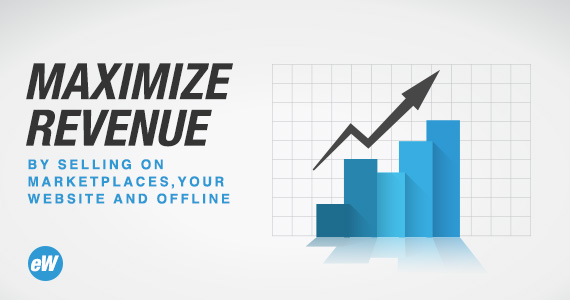 When many retailers start up they will often ask themselves “Shall I sell on my own website?” or “Shall I sell on a marketplace like Amazon or eBay?”.
When many retailers start up they will often ask themselves “Shall I sell on my own website?” or “Shall I sell on a marketplace like Amazon or eBay?”.
In 2016 there isn’t a case for Marketplace vs Website, you should be selling on both and there are resources available that have made it easy to do so.
It’s understandable why retailers would be reluctant to branch out on to multiple sales channels in the past.
Questions such as “Where will I store my products?”, “How will I handle the extra orders and workload?” and “How will I know if I’m making a profit across all my channels?”.
This article explores the benefits of marketplaces, a website and offline sales. Plus how you can bring that all together to make selling easier.
Before that, why are marketplaces such as eBay and Amazon an integral part of modern day multichannel selling?
THE BENEFITS OF MARKETPLACES
The most obvious benefit of marketplaces is the tremendous potential customer base it can bring you initially.
Building up traffic and sales when your site is in its infancy can be difficult, but exposure is almost instant on a marketplace.
Some other key benefits of marketplaces include:
- Time to revenue – Whereas SEO, PPC and marketing might take some time on your own site, it is lighting fast to have your products visible on marketplaces.
- Trust – Amazon/eBay are trusted websites and conversion rates are high.
- Tax – Tax collection and credit card processes won’t have to be handled by yourself.
- Recommendations – Someone may visit Amazon to buy a product that you don’t even sell, and your product may come up in a recommended purchase.
One negative that retailers will always mention with marketplaces is that there are fees involved with selling and this can put a lot of people off.
However this will pale into insignificance when you consider that marketplaces include no costs for maintenance, design or development work.
Here’s a list of a few marketplaces that are definitely worth exploring for retailers:
- Amazon – A little known marketplace that 44% of all shoppers go straight to. Not only that but it has more consumer searches than Google. Services like Prime make it incredibly popular with millennials, as nearly 20% of all US millennials own a Prime account. Pretty huge when you consider there are 80 million millenials just in the US spending around $200 billion annually.
- eBay – A marketplace that is often misconceived by sellers. Perceived as a site for ‘junk sellers’ or part-timers, it actually boasts a better profit margin for sellers than Amazon. 11 million searches are made every hour on eBay and around $20 billion was spent on its mobile app last year.
- Wanelo – We all now aware of how important mobile is for online shoppers. Therefore Wanelo is essential for retailers as 85% of people who shop on there do so by mobile. There are currently 350k+ stores selling 200 million products, what are you waiting for!
- Etsy – Absolutely essential if you sell ‘hand-made’ products. A committed customer base that spent over $2 billion in 2015. The site also boasts an impressive 81% of purchases coming from repeat business.
- Jet – A new player in the marketplace field, currently boasts a customer base of around 4 million in less than a year. To put that in perspective it is growing 280x faster than Amazon!
THE BENEFITS OF A WEBSTORE
The thought of setting up and running a website would have the majority of technophobes running for the hills.
This would have especially been the case 10 years ago, but now even your grandmother could set up a website, yes, that easy.
Cloud based solutions like Shopify and Bigcommerce ensure that all complexities such as hosting, server configuration, credit card processing, security and coding are handled by the platform themselves.
Before we dive into the benefits of each platform, what are the overall benefits of selling on your own website?
- Brand Awareness – There are no restrictions on how you market your business. It’s also a good idea to drive traffic from your marketplaces to your stores. This will help convert buyers into fans.
- Apps/Plugins – With a click of a button you can add a powerful sales, marketing or shipping feature to your site instantly.
- Analytics – In depth analytics of your site can give you an insight into customer habits and help with scalability.
- Search Engine Visibility – A great landing page with relevant keywords and links can make you accessible to millions of potential buyers.
- Higher Profit Margin – No competition and no monthly seller fees mean you can list products at a higher price than your marketplaces.
- Customizable – Add your own theme, product imagery, videos and stories to create something bespoke for your business.
So when considering an e-commerce platform there are two options, hosted and self-hosted.
The hosted option removes a lot of the complications and barriers that sellers had before. 2 great options are:
- Shopify – Easy to use interface and a setup wizard makes it incredibly popular with beginners. A whole host of themes, 24/7 support, technical assistance, a plethora of payment gateways and fast loading speeds make it a great option.
- Bigcommerce – Unlimited product uploads, initiative coupon offerings, a great blogging platform and easy setup make this a worthy competitor of Shopify’s. An integration with Alibaba allows you access to over 300 top suppliers.
As for self-hosted which means that you can either manage the security and hosting of your site or you can outsource it to someone else.
- Magento – The most scalable platform of the ones mentioned. It supports multi-currency, multi-storefronts and multi-languages. With Magento you can create a much more bespoke website, whereas say with Shopify there are 1000s of sites that have a variation of the same theme.
- WooCommerce – A plugin for the blogging platform WordPress. Therefore the SEO value and ability to attract visitors to your site is great with this platform. If you already run a blog this is ideal because it will be familiar. It’s also the world’s most possible ecommerce solution, so general and forum support is great.
USE A POP-UP TO YOUR ADVANTAGE
Did you know that there are 1.2 billion online-only companies?
This can be translated to mean that it is becoming increasingly difficult to establish yourself in an online world that’s becoming increasingly competitive.
So how can you set yourself apart from everyone else?
You can do so through offline sales and in particular using a pop-up store. There are some great sites that will help you locate space, set up and sort out insurance such as Republic Spaces, Pop Up Republic, High Jam and Appear Here.
Other benefits of a pop-up store include…
- Expose yourself to potential new customers.
- No capital-intensive expansion.
- Don’t have to sign a contract.
- Great use of product feedback from customers.
BRING THEM ALL TOGETHER
By this point you’re probably wondering how you can manage a webstore, several marketplaces and a pop-up?
Pushing products to these channels, managing stock effectively, printing shipping labels and wondering what your overall profit is can prove difficult.
The last thing you want to do is logging in to separate programs, exporting reports and orders and subsequently wasting a lot of your precious time.
That’s where inventory management software comes in to make sellers lives easier.
Ensuring items are stocked and not overselling across two channels are big problems facing retailers. In fact 46% of SMBs are either not managing their inventory or are doing so manually.
This has resulted in retailers losing $1.1 trillion every single year due to stocking issues.
A good inventory management system will not only update stock levels but will manage all your purchase orders to suppliers, link with your accounting software, bulk print shipping labels and generate sales reports across all your channels.
So what are you waiting for? Stop relying on just one revenue stream for the livelihood of your business and sell multi-channel today!
Richard Protheroe is a Marketing Executive at Veeqo. Do you have a Shopify, Amazon and eBay integration? Sync your inventory up and save time and money today.






